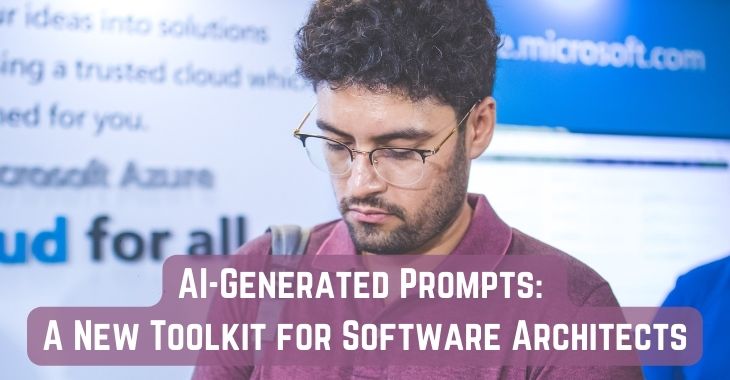
“Once again Saltmarch has knocked it out of the park with interesting speakers, engaging content and challenging ideas. No jetlag fog at all, which counts for how interesting the whole thing was."
Cybersecurity Lead, PwC

AI-generated prompts offer a transformative approach to software architecture and design. This article explores their application throughout the software architecture lifecycle. These prompts functions as a targeted tool, designed to tackle specific challenges in software design. From automated summarization to preparing for upcoming technologies, they provide effective solutions that boost efficiency and foster innovation.
By the time you finish reading this article, you'll gain a thorough understanding of how AI-generated prompts can transform different aspects of the software architecture lifecycle.
Efficiency in software architecture isn't a single, unified idea; it's made up of multiple facets like quality, agility, performance, and readiness for future technologies. The real challenge is in balancing these facets effectively. AI-generated prompts provide a toolkit that helps architects manage these complexities with a level of precision that was previously hard to achieve.
Automated Summarization: In an environment saturated with data, finding what's essential is crucial. A prompt such as "Summarize this 300-page technical document concisely" acts as an effective filter, helping architects zero in on the most important information.
Quality Enhancement: Quality in software architecture is a variable factor. Using prompts like "Recommend improvements for this serverless architecture" can serve as a precise adjuster, improving architectural quality based on data.
Agile Adaptation: Agility in architecture isn't just about quickness; it's about smooth transitions between project stages. Prompts such as "Outline a transition plan from design to implementation" help ensure these transitions are seamless.
Performance Tuning: Performance isn't a one-time metric; it's an ongoing process of improvement. A prompt like "Suggest optimization methods for this real-time analytics engine" serves as a tool for actionable performance enhancements.
Future Readiness: Prompts like "Evaluate the impact of edge computing on this IoT architecture" provide valuable insights into upcoming technologies and trends.
Imagine you're an architect who has successfully gathered all the necessary requirements. Now you're tasked with converting these into a high-level architectural design. You face two main challenges: selecting the right architectural patterns and identifying potential bottlenecks or vulnerabilities early on.
In this section, we delve into how AI-generated prompts can act as specialized tools for architects, especially in the areas of design paradigms, framework selection, and early identification of pitfalls. These prompts enable architects to make data-driven decisions, enhancing both the immediate design and the long-term viability of their projects.
Picking the appropriate design paradigm is often a nuanced decision, influenced by multiple factors such as performance needs and future scalability. While architects traditionally rely on their experience and gut feeling, AI-generated prompts like "Suggest design paradigms for low-latency requirements" offer a data-driven alternative. The AI outputs a curated list of design paradigms, complete with their advantages and disadvantages, enabling you to make a well-informed decision specific to your project.
The long-term sustainability of a chosen framework is a crucial factor, particularly for projects with a long lifespan. Architects usually have to balance immediate gains against future scalability and upkeep. A prompt like "Evaluate the long-term viability of a reactive architecture for this project" provides invaluable insights. The AI outputs a detailed analysis that not only highlights immediate benefits but also considers long-term implications, aiding you in making a balanced choice.
Identifying bottlenecks or vulnerabilities late in the development process can be expensive. To mitigate this, architects can use AI-generated prompts as an early warning mechanism. A prompt like "Identify security vulnerabilities in this serverless architecture" can highlight potential issues well before they become critical, allowing for proactive measures to ensure a robust architecture.
Suppose a key requirement is to develop a scalable microservices architecture for an e-commerce platform. Traditional methods often involve in-depth research and discussions about scalability, inter-service communication, and data integrity.
With AI-generated prompts, you can focus on what matters:
By incorporating AI-generated prompts into your architectural design workflow, you're not only optimizing the process but also making robust, data-driven decisions that stand the test of time.
You've successfully gathered requirements and crafted a high-level architectural design. The next step is to turn this design into a working system. This stage presents multiple challenges: How do you translate design elements into code, select the appropriate libraries or frameworks, and maintain coding best practices?
In this section, we examine how AI-generated prompts can serve as effective tools in bridging the gap between design and implementation. These prompts offer valuable assistance to both architects and developers, aiding in code templating, library selection, and the establishment of coding standards. The end result is a more efficient, streamlined, and maintainable development process.
Translating design elements into code often requires a lot of back-and-forth between architects and developers. AI-generated prompts can simplify this process. For example, a prompt like "Generate a GoLang template for this RESTful API" can act as a connector. The AI outputs a code template that aligns closely with the design, reducing friction and speeding up the implementation.
The sheer number of available libraries and APIs can make selection overwhelming. AI-generated prompts can help here too. A prompt like "Recommend efficient data storage libraries for real-time analytics" can provide a curated list of options. These suggestions meet not only the functional requirements but also align with the project's performance and scalability needs, ensuring you pick the most suitable tools.
Maintaining a consistent coding style and adhering to best practices are essential for long-term project sustainability. A prompt like "Create a set of coding standards for this blockchain project" can be extremely useful. The AI outputs a customized set of coding guidelines that act as a framework for consistency, making the codebase easier to manage.
Let's say one of your architectural components is a real-time event processing system designed to handle millions of events per second. Traditional methods often involve deep dives into research for the right programming languages, data storage solutions, and event processing libraries.
With AI-generated prompts, you can focus your efforts:
By integrating AI-generated prompts into your implementation phase, you're not just speeding up the development process; you're also ensuring that the final system is robust, efficient, and in line with the architectural design.
You've successfully completed the stages of requirements gathering, architectural design, and code implementation. Now you've reached a crucial point: making sure the system you've built is both reliable and robust. The challenge is straightforward but intricate: How do you create detailed test scenarios, spot often-missed edge cases, and pick the right testing tools?
In this section, we delve into how AI-generated prompts can be instrumental in software testing and verification. These prompts serve as specialized tools that significantly improve the thoroughness, accuracy, and efficiency of your testing process. From designing test scenarios to choosing the right testing tools, these prompts offer targeted solutions that enhance your software's quality.
Creating test scenarios is a nuanced activity, heavily dependent on how requirements are interpreted. This can lead to potential gaps or oversights. An AI-generated prompt like "Create test scenarios for validating data integrity in this distributed database" can be transformative. The AI outputs a complete set of test scenarios, ensuring that all facets of data integrity are rigorously checked.
Edge cases are often missed but can surface as significant problems at inconvenient times. To proactively tackle this, a prompt like "Identify edge cases for this multi-tenant SaaS application" can be extremely useful. The AI acts as an early warning system, spotting these hidden issues before they become critical.
Picking testing tools is a complex task, influenced by various factors like familiarity, functionality, and project-specific needs. A prompt like "Recommend specialized testing tools for this IoT architecture" can simplify this decision. The AI outputs a curated list of testing tools that are not only functional but also tailored to your project's unique challenges.
Suppose one of your architectural components is a multi-currency payment system designed to handle various currencies and payment gateways. Traditional testing methods might involve manually creating test scenarios for currency conversion, payment gateway integration, and transaction rollback mechanisms.
With AI-generated prompts, you can refine your testing approach:
By integrating AI-generated prompts into your testing and verification stage, you're not just achieving comprehensive coverage; you're also building a system that is reliable, robust, and prepared for real-world challenges.
You've successfully navigated through requirements gathering, architectural design, implementation, and thorough testing. Now you're at the point where your system is ready for public use. But as any experienced architect will tell you, deployment isn't the finish line; it's just another starting point. The challenges are multiple: How do you deploy without hitches, maintain long-term system health, and stay current with new technologies?
In this final section, we focus on the deployment and maintenance phases of software architecture. AI-generated prompts can be extremely useful here, providing targeted solutions for deployment settings, system health monitoring, and adaptability for the future. These prompts not only make the deployment process smoother but also contribute to long-term system resilience.
Deployment is filled with complex settings that need to be precisely configured. Traditional approaches often rely on manual scripting, which is both slow and prone to errors. An AI-generated prompt like "Automatically generate an AWS CloudFormation template for this architecture" can be transformative. The AI outputs a deployment script customized for your architecture, ensuring a smooth and error-free launch.
Monitoring a deployed system's health is a complex task that goes beyond just system metrics. It requires a deep understanding of what needs to be monitored to ensure both system stability and business success. A prompt like "Provide monitoring strategies for this event-driven architecture" can offer a complete strategy. The AI gives insights that cover not just system metrics but also key business KPIs, providing a more complete view of system health.
In a fast-changing tech environment, your system needs to be adaptable to remain relevant. A prompt like "Predict the impact of 5G technology on this mobile app architecture" can offer valuable foresight. The AI analyzes the potential effects of new technologies like 5G on your architecture, helping you make informed decisions for future planning.
Suppose your project is a streaming media service designed to scale with user numbers and device types. Traditional deployment and maintenance methods might involve manual settings, reactive monitoring, and periodic reviews for new technologies.
With AI-generated prompts, you can take a proactive approach:
By incorporating AI-generated prompts into your deployment and maintenance plan, you're not just ensuring a smooth launch and stable operation; you're also preparing your system for future technologies and market shifts.
The need for evolution and innovation in software architecture is a constant companion. The challenge is not just to keep pace with the present but to anticipate and prepare for the future. As we've explored throughout this article, AI-generated prompts emerge as a versatile toolkit, capable of revolutionizing how architects approach both software design and long-term maintenance. By integrating AI-generated prompts into their arsenal, architects are not merely optimizing existing workflows, they are introducing a new way of doing things where systems are not just robust and efficient but also future-proof.
You've walked through the entire lifecycle of software architecture, from requirements gathering to deployment and maintenance. The common thread? The transformative potential of AI-generated prompts. These prompts serve as targeted tools that can streamline each phase, making your architectural process not just efficient but also resilient and adaptable for what comes next.
Incorporating AI-generated prompts into your architectural practice isn't just about improving current workflows. It's about fundamentally changing how you approach software design and long-term sustainability. With AI at your side, you're not just reacting to challenges; you're anticipating them, preparing for future technologies and market shifts that could impact your system.
So, what's the next move? Start small. Experiment with AI-generated prompts in a single phase of your next project. Measure the impact and iterate. As you gain confidence, expand the use of AI across other phases. The goal is to make data-driven decisions that are both robust and adaptable, setting your projects up for long-term success.
AI-generated prompts offer more than just a new tool; they offer a new way of thinking about software architecture. It's a change that promises not just efficiency but also a more resilient and future-ready system.
Have questions or comments about this article? Reach out to us here.
Banner Image Credits: Attendee at Great International Developer Summit

“Once again Saltmarch has knocked it out of the park with interesting speakers, engaging content and challenging ideas. No jetlag fog at all, which counts for how interesting the whole thing was."
Cybersecurity Lead, PwC

“Very much looking forward to next year. I will be keeping my eye out for the date so I can make sure I lock it in my calendar."
Software Engineering Specialist, Intuit

“Best conference I have ever been to with lots of insights and information on next generation technologies and those that are the need of the hour."
Software Architect, GroupOn

“Happy to meet everyone who came from near and far. Glad to know you've discovered some great lessons here, and glad you joined us for all the discoveries great and small."
Web Architect & Principal Engineer, Scott Davis

“Wonderful set of conferences, well organized, fantastic speakers, and an amazingly interactive set of audience. Thanks for having me at the events!"
Founder of Agile Developer Inc., Dr. Venkat Subramaniam

“What a buzz! The events have been instrumental in bringing the whole software community together. There has been something for everyone from developers to architects to business to vendors. Thanks everyone!"
Voltaire Yap, Global Events Manager, Oracle Corp.